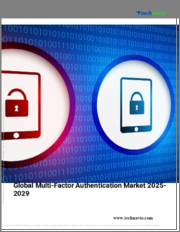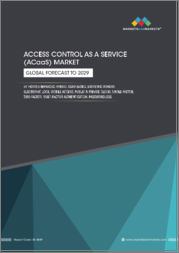
|
시장보고서
상품코드
1663810
다중 인증 시장 규모, 점유율, 성장 분석 : 인증 유형별, 모델 유형별, 컴포넌트별, 기업 규모별, 최종사용자 산업별, 지역별 - 산업 예측(2025-2032년)Multi-factor Authentication Market Size, Share, and Growth Analysis, By Authentication Type, By Model Type, By Component, By Enterprise Size, By End-User Industry, By Region - Industry Forecast 2025-2032 |
||||||
세계의 다중 인증 시장 규모는 2023년에 174억 달러로 평가되며, 예측 기간(2025-2032년)의 CAGR은 16.2%로 성장하며, 2024년 202억 2,000만 달러에서 2032년에는 672억 1,000만 달러로 성장할 전망입니다.
다단계 인증(MFA) 시장은 데이터 보호에 대한 규제 강화와 함께 사이버 공격 및 데이터 유출 빈도가 증가함에 따라 크게 성장하고 있으며, CA Technologies, Vasco Data Security, RSA Security, Symantec 등 주요 기업은 이 분야의 기술 혁신에 대한 연구개발 투자를 강화하고 있습니다. 이 분야의 기술 혁신을 위해 연구개발 투자를 강화하고 있습니다. 그러나 MFA 솔루션 도입의 복잡성은 물리적 인증 기능의 추가와 다양한 IT 환경에서의 호환성 요구로 인해 더욱 악화되고 있으며, 이는 MFA 솔루션 도입에 어려움을 겪고 있는 실정입니다. 기업이 진화하는 데이터 보안 표준에 대응하기 위해 노력하고 있지만, 조달 비용과 도입 장벽은 광범위한 채택을 방해할 수 있으며, MFA의 효과는 시간이 지남에 따라 감소할 것으로 예상되지만, 사이버 위협에 대응하기 위한 필요성으로 인해 많은 조직이 운영이 복잡하고 운영의 복잡성에도 불구하고 많은 조직들이 다요소 솔루션에 투자하고 있습니다.
목차
서론
- 조사의 목적
- 조사 범위
- 정의
조사 방법
- 정보 조달
- 2차와 1차 데이터 방법
- 시장 규모 예측
- 시장의 전제조건과 제한
개요
- 세계 시장 전망
- 공급과 수요 동향 분석
- 부문별 기회 분석
시장 역학과 전망
- 시장 개요
- 시장 규모
- 시장 역학
- 촉진요인과 기회
- 억제요인과 과제
- Porter의 산업 분석
주요 시장 인사이트
- 주요 성공 요인
- 경쟁의 정도
- 주요 투자 기회
- 시장 에코시스템
- 시장의 매력 지수(2024년)
- PESTEL 분석
- 거시경제 지표
- 밸류체인 분석
- 가격 분석
다중 인증 시장 규모 : 인증 유형별 & CAGR(2025-2032)
- 시장 개요
- 패스워드 인증
- 패스워드리스 인증
다중 인증 시장 규모 : 모델 유형별 & CAGR(2025-2032)
- 시장 개요
- 2 요소 인증
- 3 요소 인증
- 4 요소 인증
- 5 요소 인증
다중 인증 시장 규모 : 컴포넌트별 & CAGR(2025-2032)
- 시장 개요
- 솔루션
- 하드웨어
- 서비스
다중 인증 시장 규모 : 기업 규모별 & CAGR(2025-2032)
- 시장 개요
- 중소기업
- 대기업
다중 인증 시장 규모 : 최종사용자 업계별 & CAGR(2025-2032)
- 시장 개요
- BFSI
- 정부
- 여행과 이민
- 군·방위
- 상업 보안
- 헬스케어
- IT와 통신
- 미디어와 엔터테인먼트
- 기타 최종사용자
다중 인증 시장 규모 & CAGR(2025-2032)
- 북미
- 미국
- 캐나다
- 유럽
- 독일
- 스페인
- 프랑스
- 영국
- 이탈리아
- 기타 유럽 지역
- 아시아태평양
- 중국
- 인도
- 일본
- 한국
- 기타 아시아태평양
- 라틴아메리카
- 브라질
- 기타 라틴아메리카 지역
- 중동 및 아프리카
- GCC 국가
- 남아프리카공화국
- 기타 중동 및 아프리카
경쟁 정보
- 상위 5사의 비교
- 주요 기업의 시장 포지셔닝(2024년)
- 주요 시장 기업이 채택한 전략
- 최근 시장 동향
- 기업의 시장 점유율 분석(2024년)
- 주요 기업의 기업 개요
- 기업의 상세
- 제품 포트폴리오 분석
- 기업의 부문별 점유율 분석
- 매출의 전년대비 비교(2022-2024)
주요 기업 개요
- Microsoft Corporation(USA)
- Thales Group S.A.(France)
- Okta(USA)
- Broadcom, Inc.(USA)
- Micro Focus International PLC(UK)
- HID Global Corporation(USA)
- Cisco Systems, Inc.(USA)
- Oracle Corporation(USA)
- Salesforce, Inc.(USA)
- CyberArk Software Ltd.(Israel)
- Ping Identity(USA)
- ESET(Slovakia)
- Yubico(USA)
- ForgeRock(USA)
- SecureAuth(USA)
- OneSpan(USA)
- Google(USA)
- IBM(USA)
결론과 제안
KSA 25.04.01Global Multi-factor Authentication Market size was valued at USD 17.4 billion in 2023 and is poised to grow from USD 20.22 billion in 2024 to USD 67.21 billion by 2032, growing at a CAGR of 16.2% during the forecast period (2025-2032).
The multifactor authentication (MFA) market is witnessing significant growth driven by the rising frequency of cyber-attacks and data breaches, alongside increasing regulatory demands for data protection. Major players like CA Technologies, Vasco Data Security, RSA Security, and Symantec are ramping up their R&D investments to innovate in this space. However, the complexity of deploying MFA solutions, exacerbated by the need for additional physical authenticators and compatibility across diverse IT environments, presents challenges. Procurement costs and implementation hurdles may hinder broader adoption, even as businesses strive to meet evolving data security standards. While MFA effectiveness is expected to diminish over time, its necessity in combating cyber threats has prompted many organizations to invest in multifactor solutions, despite their operational complexities.
Top-down and bottom-up approaches were used to estimate and validate the size of the Global Multi-Factor Authentication market and to estimate the size of various other dependent submarkets. The research methodology used to estimate the market size includes the following details: The key players in the market were identified through secondary research, and their market shares in the respective regions were determined through primary and secondary research. This entire procedure includes the study of the annual and financial reports of the top market players and extensive interviews for key insights from industry leaders such as CEOs, VPs, directors, and marketing executives. All percentage shares split, and breakdowns were determined using secondary sources and verified through Primary sources. All possible parameters that affect the markets covered in this research study have been accounted for, viewed in extensive detail, verified through primary research, and analyzed to get the final quantitative and qualitative data.
Global Multi-Factor Authentication Market Segments Analysis
Global Multi-factor Authentication Market is segmented by Authentication Type, Model Type, Component, Enterprise Size, End-User Industry and region. Based on Authentication Type, the market is segmented into Password Authentication and Password Less Authentication. Based on Model Type, the market is segmented into Two-Factor Authentication, Three-Factor Authentication, Four-Factor Authentication and Five-Factor Authentication. Based on Component, the market is segmented into Solution, Hardware and Services. Based on Enterprise Size, the market is segmented into Small & Medium Enterprises and Large Enterprises. Based on End-User Industry, the market is segmented into BFSI, Government, Travel & Immigration, Military & Defense, Commercial Security, Healthcare, It & Telecommunication, Media & Entertainment and Other End-Users. Based on region, the market is segmented into North America, Europe, Asia Pacific, Latin America and Middle East & Africa.
Driver of the Global Multi-Factor Authentication Market
The Global Multi-Factor Authentication market is significantly driven by the rising adoption of cloud technologies, which play a crucial role in fraud detection and prevention. These technologies offer enhanced processing capabilities, ample storage solutions, and improved connectivity, greatly facilitating rapid investigations into cyber threats. Moreover, small and medium-sized businesses, particularly within the banking and financial sectors, are increasingly integrating cloud-based fraud detection and prevention services into their operations. This trend underscores the importance of leveraging advanced digital solutions to strengthen security measures against cybercrime, ultimately propelling the growth of the multi-factor authentication market on a global scale.
Restraints in the Global Multi-Factor Authentication Market
The Global Multi-Factor Authentication market faces several constraints that impede its growth potential. While there are numerous solutions to safeguard smartphones and electronic devices against phishing and security threats, a lack of understanding regarding certain authentication technologies, including behavioral biometrics and keystroke dynamics, poses a challenge. Additionally, limited consumer awareness regarding new and emerging smartphone authentication software further restricts market expansion. This knowledge gap prevents potential users from fully embracing advanced security options, thereby hindering overall market progress and adoption of innovative multi-factor authentication solutions in an increasingly digital landscape.
Market Trends of the Global Multi-Factor Authentication Market
The Global Multi-Factor Authentication (MFA) market is currently experiencing a transformative trend toward passwordless authentication solutions, fueled by a growing need for heightened security and improved user experiences. As organizations increasingly seek to mitigate risks linked to traditional password vulnerabilities-such as phishing and credential theft-biometric methods, including fingerprint and facial recognition, along with hardware tokens, are gaining prominence. Major industry players like Okta are adapting by integrating passwordless capabilities into their MFA offerings, reflecting the broader shift to more sophisticated and user-friendly authentication methods. This dynamic evolution is expected to redefine security protocols across various sectors, enhancing protection and convenience.
Table of Contents
Introduction
- Objectives of the Study
- Scope of the Report
- Definitions
Research Methodology
- Information Procurement
- Secondary & Primary Data Methods
- Market Size Estimation
- Market Assumptions & Limitations
Executive Summary
- Global Market Outlook
- Supply & Demand Trend Analysis
- Segmental Opportunity Analysis
Market Dynamics & Outlook
- Market Overview
- Market Size
- Market Dynamics
- Drivers & Opportunities
- Restraints & Challenges
- Porters Analysis
- Competitive rivalry
- Threat of substitute
- Bargaining power of buyers
- Threat of new entrants
- Bargaining power of suppliers
Key Market Insights
- Key Success Factors
- Degree of Competition
- Top Investment Pockets
- Market Ecosystem
- Market Attractiveness Index, 2024
- PESTEL Analysis
- Macro-Economic Indicators
- Value Chain Analysis
- Pricing Analysis
Global Multi-factor Authentication Market Size by Authentication Type & CAGR (2025-2032)
- Market Overview
- Password Authentication
- Password Less Authentication
Global Multi-factor Authentication Market Size by Model Type & CAGR (2025-2032)
- Market Overview
- Two-Factor Authentication
- Three-Factor Authentication
- Four-Factor Authentication
- Five-Factor Authentication
Global Multi-factor Authentication Market Size by Component & CAGR (2025-2032)
- Market Overview
- Solution
- Hardware
- Services
Global Multi-factor Authentication Market Size by Enterprise Size & CAGR (2025-2032)
- Market Overview
- Small & Medium Enterprises
- Large Enterprises
Global Multi-factor Authentication Market Size by End-User Industry & CAGR (2025-2032)
- Market Overview
- BFSI
- Government
- Travel & Immigration
- Military & Defense
- Commercial Security
- Healthcare
- It & Telecommunication
- Media & Entertainment
- Other End-Users
Global Multi-factor Authentication Market Size & CAGR (2025-2032)
- North America (Authentication Type, Model Type, Component, Enterprise Size, End-User Industry)
- US
- Canada
- Europe (Authentication Type, Model Type, Component, Enterprise Size, End-User Industry)
- Germany
- Spain
- France
- UK
- Italy
- Rest of Europe
- Asia Pacific (Authentication Type, Model Type, Component, Enterprise Size, End-User Industry)
- China
- India
- Japan
- South Korea
- Rest of Asia-Pacific
- Latin America (Authentication Type, Model Type, Component, Enterprise Size, End-User Industry)
- Brazil
- Rest of Latin America
- Middle East & Africa (Authentication Type, Model Type, Component, Enterprise Size, End-User Industry)
- GCC Countries
- South Africa
- Rest of Middle East & Africa
Competitive Intelligence
- Top 5 Player Comparison
- Market Positioning of Key Players, 2024
- Strategies Adopted by Key Market Players
- Recent Developments in the Market
- Company Market Share Analysis, 2024
- Company Profiles of All Key Players
- Company Details
- Product Portfolio Analysis
- Company's Segmental Share Analysis
- Revenue Y-O-Y Comparison (2022-2024)
Key Company Profiles
- Microsoft Corporation (USA)
- Company Overview
- Business Segment Overview
- Financial Updates
- Key Developments
- Thales Group S.A. (France)
- Company Overview
- Business Segment Overview
- Financial Updates
- Key Developments
- Okta (USA)
- Company Overview
- Business Segment Overview
- Financial Updates
- Key Developments
- Broadcom, Inc. (USA)
- Company Overview
- Business Segment Overview
- Financial Updates
- Key Developments
- Micro Focus International PLC (UK)
- Company Overview
- Business Segment Overview
- Financial Updates
- Key Developments
- HID Global Corporation (USA)
- Company Overview
- Business Segment Overview
- Financial Updates
- Key Developments
- Cisco Systems, Inc. (USA)
- Company Overview
- Business Segment Overview
- Financial Updates
- Key Developments
- Oracle Corporation (USA)
- Company Overview
- Business Segment Overview
- Financial Updates
- Key Developments
- Salesforce, Inc. (USA)
- Company Overview
- Business Segment Overview
- Financial Updates
- Key Developments
- CyberArk Software Ltd. (Israel)
- Company Overview
- Business Segment Overview
- Financial Updates
- Key Developments
- Ping Identity (USA)
- Company Overview
- Business Segment Overview
- Financial Updates
- Key Developments
- ESET (Slovakia)
- Company Overview
- Business Segment Overview
- Financial Updates
- Key Developments
- Yubico (USA)
- Company Overview
- Business Segment Overview
- Financial Updates
- Key Developments
- ForgeRock (USA)
- Company Overview
- Business Segment Overview
- Financial Updates
- Key Developments
- SecureAuth (USA)
- Company Overview
- Business Segment Overview
- Financial Updates
- Key Developments
- OneSpan (USA)
- Company Overview
- Business Segment Overview
- Financial Updates
- Key Developments
- Google (USA)
- Company Overview
- Business Segment Overview
- Financial Updates
- Key Developments
- IBM (USA)
- Company Overview
- Business Segment Overview
- Financial Updates
- Key Developments



















